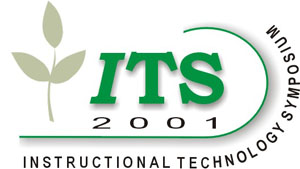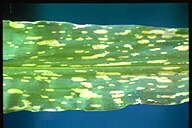Illustrated Encyclopedia of Forage Crop
Diseases
Takao
TSUKIBOSHI and Tadayuki SHIMANUKI*
National Institute of Agro-Environmental Sciences
*Hokkaido National Agricultural Experiment Station
JAPAN
|
 |
|
|
As forage crops
consist of more than 90 species in 40 genera
belonging mainly to Gramineae and Leguminosae,
the diseases associated with these plants are also very varied. When
an unknown disease occurs, an appropriate diagnosis is necessary
in order to control it. Moreover, as the climate of our
country differs from the
Americas and the Oceanic nations, disease symptoms can be quite
different from those shown in publications from these
countries. The internet
is a good way to provide information assisting with diagnosis,
so we have established "Illustrated
Encyclopedia of Forage Crop Diseases". This resource
is based
on research undertaken by the plant disease laboratory
of National Grassland Research Institute (NGRI),
Japan in 1996. |
|
|
Causal
organism: Cochliobolus
heterostrophus (Drechsler) Drechsler,
Ascomycotina
The most important
fungal disease. The disease begins to occur at
the end of the rainy season and the lesions that
are orange to yellow brown, oval, 0.5-2 x 2-5mm
in size are produced in leaves and sheaths. The
entire plant is often killed when the disease
occurs severely. The occurrence of the disease
increases at the later period of growth. Three
races are known corresponding to the types of
male sterile cytoplasm of corn and race O is
mainly occurring in Japan.
|
This database is established
at the website of NGRI (URL:http://ss.ngri.affrc.go.jp/). Diseases of 82 grass and legume
species of 58 genera (including corn, sorghum,
orchardgrass, ryegrass, alfalfa, clover, bentgrass,
zoysia grass, millet, weeds and etc.) are covered. Descriptions
include photographs of the symptoms and pathogens. In total there are 385 photographs of disease symptoms and 144 of
pathogens in the database.
Retrieval of the diseases from the database can be performed by 3 ways as described below.
1. Retrieval by plant names
followed by disease names
When you select the plant which you want to retrieve, you
can select the disease name associated with each plant. Because the
disease names are shown with
thumbnail pictures (JPEG, 2-3kb), you can judge whether or not they seem
to match the disease being diagnosed. Then you can see the full size (JPEG, 20-30kb)
of the pictures of symptoms and pathogens. Literature
related to the disease and published in Japan since 1980, is also listed.
2. Retrieval by pathogen names
Retrieval by pathogen names is also possible. When you select the "genus" name,
virus bacteria, phytoplasma, Mastigomycotina,
Ascomycotina, Basidiomycotina or unknown fungi in the
left frame, you are shown a list of the species names
in the right frame. The disease's) caused by these species can
then be accessed.
3. Retrieval by symptoms
The symptom retrieval function can be used to diagnosis diseases you are
unsure of. You
firstly decide the symptom is a systemic one such as
distortion and dwarfing, a symptom on flowers or ears
such as smut and ergot or local lesions on leaves and
sheaths. If you go into the local lesion page, you can
decide then whether the main symptom is abundant pustules (rust), a white powdery
appearance (powdery mildew) or lesions of various
shapes with or without small structures (pycnidia or acervuli).
In addition, the image list of the pathogens of the graminicolous Bipolaris,
Drechslera and Exserohilum (conidia) and rust fungi
(uredospores and teleutospores) are available. Data on
other fungi will also be added in future.
End
|

